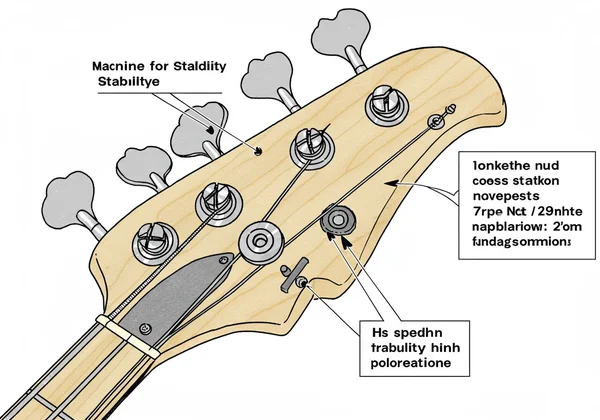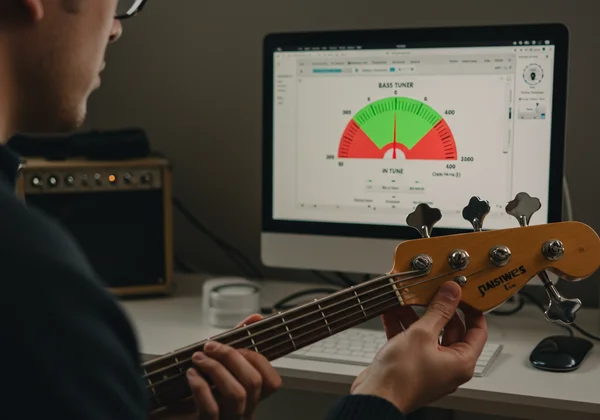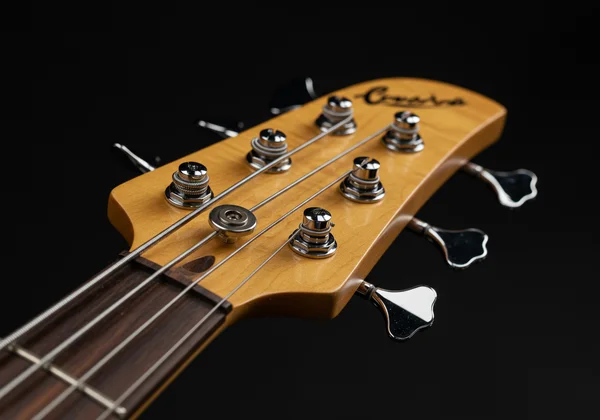Ultimate Bass Tuning Guide: Tune Your Bass Guitar Perfectly
The sound of a perfectly tuned bass guitar is the foundation of any great song. It’s the sonic glue that holds the rhythm and harmony together. But if you're just starting, you might wonder how to tune a bass guitar? This ultimate bass tuning guide will demystify the entire process, providing clear, step-by-step instructions and essential tips to ensure your bass always sounds its best. Whether you're a complete beginner or a seasoned player, you'll find everything you need right here.
A properly tuned instrument is your first step toward incredible tone. It makes practicing more enjoyable and ensures you sound professional when playing with others. The good news is that with the right knowledge and a reliable tool, tuning is a quick and simple task. Let's dive in and get your bass ready to rock. For an instant solution, you can always use a free online tuner.
Understanding the Fundamentals of Bass Guitar Tuning
Before you twist a single tuning peg, understanding a few basics will make the process much smoother. Think of this as learning the language of your instrument. Knowing what you're aiming for is half the battle, and it empowers you to tune with confidence and precision every single time.
What is Standard Bass Tuning (EADG) and Why It Matters?
For a standard four-string bass, the notes from the thickest string (closest to you) to the thinnest are E, A, D, and G. This is known as standard bass tuning, or EADG tuning. This tuning is the universal standard used in the vast majority of popular music, from rock and pop to funk and jazz.
Why is this standard so important? It creates a consistent musical foundation, allowing bassists worldwide to read music, learn songs, and play together seamlessly. When someone tells you a riff, they assume you are in standard tuning. Mastering EADG is the essential starting point for every bassist.
How a Digital Bass Tuner Works: Pitch, Cents, and Visual Feedback
A digital tuner, like our free online bass tuner, works by listening to the sound your bass makes. It analyzes the frequency, or pitch, of the note you play. This pitch is measured in Hertz (Hz). Each note (E, A, D, G) has a specific target frequency.
The tuner then shows you how close you are to that target. This deviation is often measured in cents, where 100 cents equal one semitone (the distance to the next note). A good tuner will show you if you are "flat" (too low) or "sharp" (too high) and by how many cents. Our online bass tool provides instant visual feedback with a needle and color codes (red for out-of-tune, green for in-tune) to make this incredibly simple.
Key Bass Parts That Influence Tuning Stability
Several parts of your bass guitar affect how well it stays in tune. Familiarizing yourself with them can help you troubleshoot issues. The most important are the machine heads (or tuning pegs) on the headstock. These are what you turn to adjust the string tension and pitch.
The strings also pass over the "nut" at the top of the neck and the "bridge" on the body. If these parts are worn or poorly set up, strings can get stuck, causing tuning problems. Finally, the quality and age of your bass strings play a huge role; old, worn-out strings will struggle to hold their pitch.

Step-by-Step: How to Tune Your Bass Guitar for Beginners
Ready to get in tune? This simple, step-by-step process will guide you through tuning your bass guitar perfectly. It’s designed for beginners but serves as a great refresher for any player. We'll use our recommended browser bass tuner for this guide, as it’s free, accurate, and incredibly easy to use.
Preparing Your Bass for Accurate Tuning
First, find a quiet space to minimize background noise that could interfere with the tuner's microphone. Plug your electric bass into an amplifier if you have one, and set the volume to a moderate level with a clean tone. This provides a strong, clear signal for the tuner.
Gently stretch each string by pulling it away from the fretboard a few times. This helps settle new strings and ensures they hold their tune better. Finally, make sure your bass is in a comfortable playing position, just as you would hold it when playing.
Using Our Free Online Bass Tuner: Your Digital Companion
Now, it’s time to use the best tool for the job. Navigate to our online bass tuner on your computer or smartphone. The first time you visit, your browser will ask for permission to use your microphone—be sure to click "Allow." This is completely secure and only used for real-time tuning.
Our tuner features a brilliant dual interface: a visual headstock that’s perfect for beginners and a high-precision dial for experienced players. Click the "START" button to activate it. You can select the string you want to tune by clicking on the corresponding tuning peg on the screen or the note name on the side.

Tuning Each String: E, A, D, G (and Beyond!)
Start with the thickest string, the low E string. Pluck it firmly and let it ring out. Watch the tuner on the screen.
- If the needle is to the left (flat), the note is too low. Slowly turn the corresponding tuning peg to tighten the string, raising the pitch.
- If the needle is to the right (sharp), the note is too high. Slowly loosen the string to lower the pitch.
- Aim for the middle. Adjust until the needle is centered and the indicator turns green. The tuner will confirm you've hit the correct note (E).
Repeat this process for the remaining strings: A, then D, and finally G. Once you've tuned all four strings, it's a good habit to go back and double-check them all one more time, as adjusting the tension on one string can slightly affect the others.
Beyond the Basics: Advanced Bass Tuning Techniques
Once you've mastered standard tuning, a whole new world of sonic possibilities opens up. Alternate tunings can change the feel of your bass, unlock heavier tones, and inspire new creative ideas. Let's explore some of the most common advanced tunings.
How to Tune a 5-String Bass (BEADG) Accurately
A 5-string bass adds an extra thick string, typically a low B. The standard tuning for a 5-string bass is B-E-A-D-G. The process is exactly the same as with a 4-string, you just have one more string to tune. Our 5 string bass tuner is perfectly capable of recognizing this lower note accurately. Simply tune your E, A, D, and G strings as usual, and then tune your lowest string to B.

Exploring Drop D Tuning on Bass: The Low-End Powerhouse
Drop D tuning is one of the most popular alternate tunings in rock and metal music. It involves lowering your E string by a whole step down to D, while the other strings (A, D, G) remain the same. This creates a powerful, heavy sound and makes playing root-fifth power chords on the lower strings much easier. To achieve this, simply tune your E string down until the tuner shows a perfect D.
Other Popular Alternate Bass Tunings and Their Uses
Beyond Drop D, there are many other tunings to explore. D Standard tuning (DGCF) lowers every string by a whole step, providing a deeper, heavier overall tone. C Standard (CFA#D#) goes even lower. Some players experiment with open tunings, where the open strings form a chord, which is more common on guitar but can be used for creative bass lines. You can use a versatile electric bass tuner to achieve any of these variations.
Troubleshooting Common Bass Tuning & Stability Issues
Sometimes, you might find your bass just doesn't want to stay in tune. This can be frustrating, but the causes are usually simple and easy to fix. Understanding these common issues will help you keep your instrument in perfect playing condition.
Why Does My Bass Go Out of Tune So Quickly? (And How to Fix It)
If your bass constantly falls out of tune, the most common culprits are old strings. Bass strings lose their elasticity and ability to hold pitch over time. If they're more than a few months old, replacing them can make a world of difference for your tuning stability.
Another cause can be improperly wound strings on the tuning posts. Ensure you have three to four neat wraps around each post. Finally, drastic changes in temperature and humidity can cause the wood of your bass to expand or contract, affecting tuning. Let your instrument acclimate to new environments before a performance.
What to Do If Your Bass is Buzzing After Tuning
Fret buzz is a common issue where the string vibrates against a fret, creating an unwanted buzzing sound. If this happens right after tuning, it could be that your action (the height of the strings off the fretboard) is too low. This can be a more complex fix involving adjustments to the bridge or even the truss rod in the neck.
For simple buzzes, first ensure you are fretting the notes correctly and with enough pressure. If the bass buzzing persists across many frets, it may be time for a professional setup from a guitar technician. They can adjust the instrument's intonation and action for optimal playability.
Master Your Tone: Your Journey to Perfectly Tuned Bass
You now have a complete understanding of how to tune your bass guitar, from the fundamentals of standard tuning to advanced techniques and troubleshooting. Consistent, accurate tuning is a non-negotiable skill for every bassist. It builds your ear, improves your playing, and ensures you always contribute a solid, professional foundation to any music you create.
Ready to put your newfound knowledge into practice? There's no need to download an app or buy extra hardware. Head over to our online bass tuner now and experience the accuracy and ease of this free tool. Get perfectly in-tune instantly!
Frequently Asked Questions About Bass Tuning
How do you tune a bass guitar for beginners effectively?
The most effective way for beginners is to use a visual chromatic tuner. Start with the thickest string (E), pluck it, and adjust the tuning peg until the tuner shows a green light or a centered needle. Then, repeat for the A, D, and G strings. Using a simple online tuner makes this process intuitive and fast.
What are the standard notes for a 4-string bass guitar?
The standard notes for a 4-string bass, from the thickest to the thinnest string, are E, A, D, and G. This is the foundation for nearly all modern music and is the first tuning every bassist should master.
Can I use my smartphone to tune my bass guitar accurately?
Absolutely! Your smartphone's built-in microphone is more than capable of picking up your bass guitar's frequency. A browser-based tool like our online bass tuner turns your phone or laptop into a high-precision tuner without needing to install any apps, saving you space and protecting you from ads.
Why does my bass seem to go out of tune so quickly?
The most common reasons are old strings that have lost their tension, new strings that haven't been stretched properly, or slipping machine heads. Extreme temperature changes can also affect the wood and cause the bass to go out of tune.
Is an online bass tuner as reliable as a physical pedal tuner?
Yes, a high-quality online tuner is extremely reliable. Modern web technology, like the Web Audio API used by our tuner, allows for incredibly accurate pitch detection that rivals many hardware pedals. For practicing, songwriting, or quick tune-ups, a free bass guitar tuner is an excellent and convenient choice.